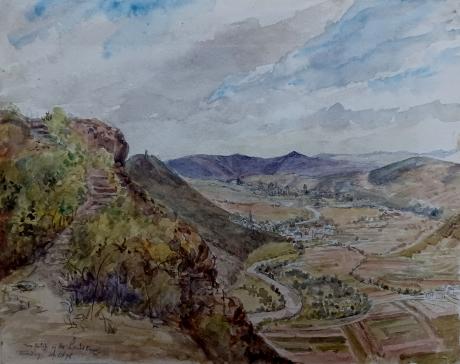inscribed and dated "From the Hill Top of the Landskrone Tues Sep 5 1875" and signed with initials "LWT"
Tom and Laura Taylor and thence by descent
The Landskrone in the borough of Bad Neuenahr-Ahrweiler in the German state of Rhineland-Palatinate is a hill, 271.7 m above sea level (NHN), in the Middle Rhine area. It used to be called the Gimmiger Berg and Gymmicher Kupp, but is now named after the ruins of the imperial castle of Landskron [de] which are found on its heights. On the western hillside of the Landskrone is the Chapel of Our Lady of Perpetual Succour (Maria-Hilf-Kapelle) or St. Mary's Chapel (Marienkapelle).
-
The Landskrone around 1900 with the village of Heppingen and St. Mary's Chapel on its western flanks
-
Landskrone, 2016 aerial photograph
The Landskrone is part of the northern foothills of the lower Ahr Valley. It lies east of Bad Neuenahr between Gimmigen in the north-northwest and Heppingen in the west, Heimersheim in the south and Lohrsdorf in the east, all belonging to the borough of Bad Neuenahr-Ahrweiler. To the south the River Ahr flows past from east to west, which is joined by the Leimersdorfer Bach (Heppinger Bach) to the southwest and to the Lohrsdorfer Bach to the east-southeast.
Laura Wilson Barker (6 March 1819 – 22 May 1905), was a composer, performer and artist, sometimes also referred to as Laura Barker, Laura W Taylor or "Mrs Tom Taylor".
She was born in Thirkleby, North Yorkshire, third daughter of a clergyman, the Rev. Thomas Barker. She studied privately with Cipriani Potter and became an accomplished pianist and violinist. As a young girl Barker performed with both Louis Spohr and Paganini. She began composing in the mid-1830s - her Seven Romances for voice and guitar were published in 1837. From around 1843 until 1855 she taught music at York School for the Blind. During this period some of her compositions - including a symphony in manuscript, on 19 April 1845 - were performed at York Choral Society concerts.
On 19 June 1855 she married the English dramatist, critic, biographer, public servant, and editor of Punch magazine Tom Taylor. Barker contributed music to at least one of her husband's plays, an overture and entr'acte to Joan of Arc (1871), and provided harmonisations as an appendix to his translation of Ballads and Songs of Brittany (1865).
Her other works include the cantata Enone (1850), the violin sonata A Country Walk (1860), theatre music for As You Like It, (April 1880), Songs of Youth (1884), string quartets, madrigals and solo songs. Her choral setting of Keats's A Prophecy, composed in 1850, was performed for the first time 49 years later at the Hovingham Festival in 1899. The composer was present.
Several of Barker's paintings hang at Smallhythe Place in Kent, Ellen Terry's house.
Barker lived with her husband and family at 84 Lavender Sweep, Battersea. There were two children: the artist John Wycliffe Taylor (1859–1925), and Laura Lucy Arnold Taylor (1863–1940). The Sunday musical soirees at the house attracted many well-known attendees, including Lewis Carroll, Charles Dickens, Henry Irving, Charles Reade, Alfred Tennyson, Ellen Terry and William Makepeace Thackeray.
Tom Taylor died suddenly at his home in 1880 at the age of 62. After his death, his widow retired to Porch House, Coleshill in Buckinghamshire, where she died on 22 May 1905, aged 86.



